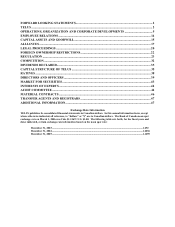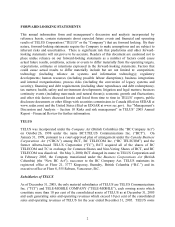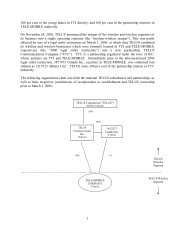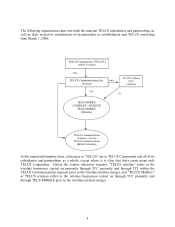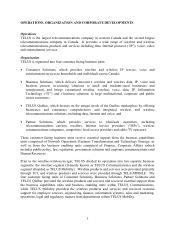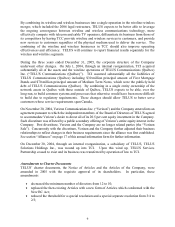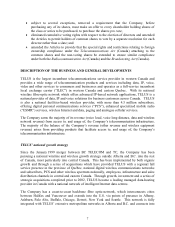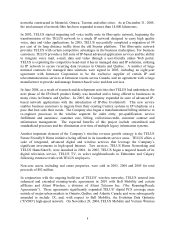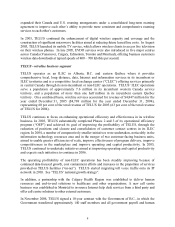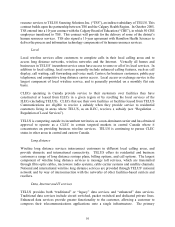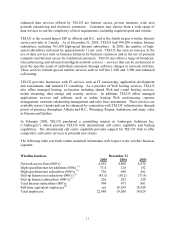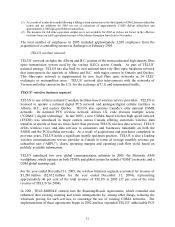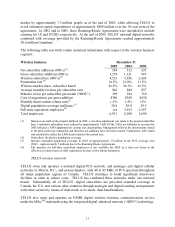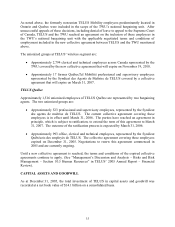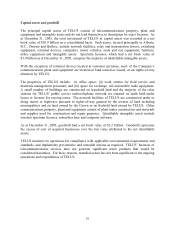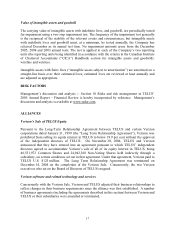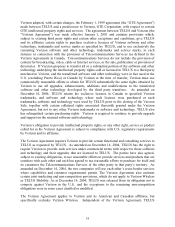Telus 2005 Annual Report Download - page 10
Download and view the complete annual report
Please find page 10 of the 2005 Telus annual report below. You can navigate through the pages in the report by either clicking on the pages listed below, or by using the keyword search tool below to find specific information within the annual report. 9
expanded their Canada and U.S. roaming arrangements under a consolidated long-term roaming
agreement to improve each other’s ability to provide more consistent and comprehensive roaming
services to each other’s customers.
In 2005, TELUS continued the enhancement of digital wireless capacity and coverage and the
construction of significant microwave facilities aimed at reducing future leased line costs. In August
2005, TELUS launched its mobile TV service, which allows wireless clients to access live television
on their wireless phones. In late 2005, EVDO services were also introduced in five major centres
across Canada (Vancouver, Calgary, Edmonton, Toronto and Montreal), offering business customers
wireless data downloads at typical speeds of 400 – 700 kilobits per second.
TELUS - wireline business segment
TELUS operates as an ILEC in Alberta, B.C. and eastern Québec where it provides
comprehensive local, long distance, data, Internet and information services in its incumbent or
ILEC territories and is a competitive local exchange carrier (“CLEC”) offering services primarily
in central Canada through its non-incumbent or non-ILEC operations. TELUS’ ILEC operations
serve a population of approximately 7.6 million in its incumbent western Canada service
territory, and a population of more than one half million in its incumbent eastern Québec
territory. On a combined basis, wireline services accounted for revenue of $4,847 million for the
year ended December 31, 2005 ($4,769 million for the year ended December 31, 2004),
representing 60 per cent of the total revenue of TELUS for 2005 (63 per cent of the total revenue
of TELUS for 2004).
TELUS continues to focus on enhancing operational efficiency and effectiveness in its wireline
business. In 2003, TELUS substantially completed Phases 2 and 3 of its operational efficiency
program (“OEP”) and achieved its goal of improving the profitability of TELUS, through the
reduction of positions and closure and consolidation of customer contact centres in its ILEC
region. In 2004, a number of comparatively smaller initiatives were undertaken, noticeably in the
information technology resources area and in the merger of two customer-facing business units,
aimed to enable greater efficiencies of scale, improve effectiveness of program delivery, improve
competitiveness in the marketplace and improve operating and capital productivity. In 2005,
TELUS continued to undertake initiatives aimed at improving operating and capital productivity
and expects such initiatives to continue in 2006.
The operating profitability of non-ILEC operations has been steadily improving because of
continued data-focused growth, cost containment efforts and increases in the proportion of services
provided on TELUS facilities (“on-net”). TELUS started migrating toll voice traffic onto its IP
network in 2003. See “TELUS’ national growth strategy”.
In addition, a partnership with the Calgary Health Region was established to deliver human
resources and end-to-end solutions to healthcare and other organizations. A new call centre
business was established in Montréal to in-source Internet help desk services from a third party and
offer call centre solutions to other external customers.
In November 2004, TELUS signed a 10-year contract with the Government of B.C., in which the
Government transferred approximately 140 staff members and all government payroll and human


